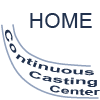|
Two-Phase Fluid Flow in Continuous Casting Nozzles
Hua Bai and Brian Thomas
Continuous Casting Consortium
Introduction
In continuous casting process, tundish nozzle geometry is one of the few variables that is both influential on the casting process and relatively inexpensive to change. The knowledge of flow pattern within the nozzle components is very important on the nozzle design. Most of the previous work has focused on the single-phase flow. In practice, argon gas is added to the nozzle to deter clogging with solid inclusions. This gas injection may greatly affects the flow pattern in the nozzle, and subsequently in the mold. Therefore, the better understanding of fluid flow in the nozzle should be based on the two-phase flow modeling.
In this project, two-phase, 3D finite difference models are created with CFX to investigate the fluid flow in the nozzle. Extensive parametric study has been performed to investigate the effects of casting speed, slide-gate opening and orientation, gas injection rate, gas bubble size, and gas injection location, etc. on the flow pattern and the jet properties.

Preliminary Conclusions
- The shape of the nozzle port has a great influence on the flow pattern and jet properties of the nozzles.
- Gas injection has a great impact on nozzle flow pattern and jet properties at normal casting speeds, but the effect of gas decreases as casting speed increases for a constant gate opening.
- The casting speed has little influence on the single-phase flow pattern in the nozzle, but has an important effect on two-phase flow. This will depend on relative port area of the nozzle vs SEN bore area.
- Gas injection may sometimes produce two jets at one side of nozzle port under normal casting speed. In this case, it is more reasonable to calculate the jet properties separately rather than using the weighted average over the whole port.
- Jet speed increases in direct proportion with casting speed for a constant gate opening and no clogging. Increasing gas injection results in higher jet speed.
- Biased flow between two ports is mainly due to the off-center throttling effect of the slide-gate. For condition of a constant gate opening and no clogging, both gas injection flow rate and casting speed have much less influence on biased mass flow.
- Increasing gas injection flow rate decreases the overall vertical jet angle due to the effect of buoyancy. The more gas injection, the shallower the overall vertical jet angle.
- The 90ƒ and 45ƒ gate orientation cases have large horizontal jet angles due to the strong single vortex at the bottom of the nozzle. This means that the average jet flow is directed away from the center plane and towards one side of the mold wideface. Specifically, if the opening in the slide-gate is near the outside radius, then jet flow will tend to impinge on the inside radius.
- Increasing casting speed (with the same slide-gate opening, thus achieved in practice by increasing tundish level) greatly increases the pressure drop across the throttling slide-gate, thus greatly decreases the minimum pressure, and results in negative pressure (air aspiration). For a constant liquid flow rate, gas injection may raise the lowest pressure, and may even raise the lowest pressure to positive level, thus eliminating the air aspiration at the low casting speed. However, this effect quickly becomes less efficient as casting speed increases.
- Bigger bubbles tend to give shallower average vertical jet angle due to greater buoyancy associated with bigger bubbles.
- The location of argon injection has an important influence on the flow pattern and jet properties, especially the overall jet angles.
Publications:
Bai, H. and B.G. Thomas, "Two-Phase Fluid Flow in Continuous Casting Nozzles", Report to Continuous Casting Consortium, UIUC, March 16, 1998.
Bai, H. and B.G. Thomas, "Two Phase Flow in Tundish Nozzles During Continuous Casting of Steel", Materials Processing in the Computer Age III, V. Voller and H. Henein, eds., TMS Annual Meeting, Nashville, TN, March 12-16, 2000, pp. 85-99. Click here for a PDF version. (932 KB)
|

